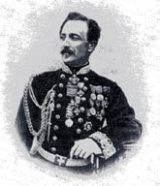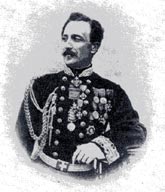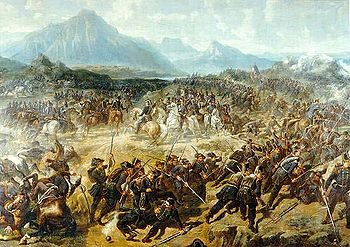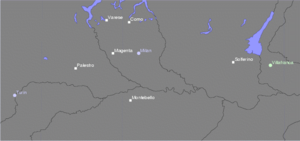
Giuseppe Govone
Encyclopedia

Isola d'Asti
Isola d'Asti is a comune in the Province of Asti in the Italian region Piedmont, located about 45 km southeast of Turin and about 8 km south of Asti....
, 1825 – Alba, Italy
Alba, Italy
Alba is a town and comune of Piedmont, Italy, in the province of Cuneo. It is considered the capital of the hilly area of Langhe, and is famous for its white truffle, peach and wine production...
, January 1872) was an Italian general and politician of Piedmontese origin, who played a major role in the Italian Risorgimento.
An officer ahead of his time, he took part in the three Wars of Independence and distinguished himself as Minister of War in the government of Giovanni Lanza
Giovanni Lanza
Domenico Giovanni Giuseppe Maria Lanza was an Italian politician and the tenth Prime Minister from 1869 to 1873.Lanza was born in the Piedmontese city of Casale Monferrato...
.
First Italian War of Independence

Pastrengo
Pastrengo is a comune in the Province of Verona in the Italian region Veneto, located about 120 km west of Venice and about 15 km northwest of Verona...
, Peschiera
Peschiera
Peschiera may refer to:*a genus of plants in the Apocynaceae family*places in Italy:**Peschiera Borromeo, in the province of Milan**Peschiera del Garda, in the province of Verona...
, and Cerlungo. Promoted to captain, he joined the staff of General Alfonso La Marmora's 6th Division.
In 1849, the 6th Division suppressed the republican Rebellion of Genoa, which broke out as a consequence of the Armistice of Vignale with Austria after the Battle of Novara
Battle of Novara
There are three military events that are called Battle of Novara, fought next to Novara, Northern Italy:* Battle of Novara , fought between France and Milan...
. In this action, Govone was able without fighting to take control of three forts on the outskirts of Genoa.
For his actions in the First Italian War of Independence
First Italian War of Independence
The First Italian War of Independence was fought in 1848 between the Kingdom of Sardinia and the Austrian Empire. The war saw main battles at Custoza and Novara in which the Austrians under Radetzky managed to defeat the Piedmontese....
, Govone was awarded two Silver medals.
Crimean War
During the Russo-Turkish War of 1853–56 (Crimean WarCrimean War
The Crimean War was a conflict fought between the Russian Empire and an alliance of the French Empire, the British Empire, the Ottoman Empire, and the Kingdom of Sardinia. The war was part of a long-running contest between the major European powers for influence over territories of the declining...
), Captain Govone played a decisive role in the defense of Silistria (May–June 1854). He drafted the plan for the inner redoubt of the city. The construction of this new redoubt prevented the Russians from taking Silistria immediately. Promoted to major, Govone took part in the famous Charge of the Light Brigade
Charge of the Light Brigade
The Charge of the Light Brigade was a charge of British cavalry led by Lord Cardigan against Russian forces during the Battle of Balaclava on 25 October 1854 in the Crimean War. The charge was the result of a miscommunication in such a way that the brigade attempted a much more difficult objective...
on October 25, 1854.
Second Italian War of Independence
On the eve of the conflict, Govone was promoted to lieutenant colonel and assigned to the General Headquarters of the King and appointed Chief of the military intelligence unit (Ufficio I). In this position, he infiltrated Austrian lines on several occasions. He also fought in the Battle of PalestroBattle of Palestro
The Battle of Palestro was fought on 30/31 May 1859 between the Austrian Empire and the combined forces of the Kingdom of Sardinia-Piedmont and France. The Franco-Piedmontese forces were victorious...
, Battle of Magenta
Battle of Magenta
The Battle of Magenta was fought on June 4, 1859 during the Second Italian War of Independence, resulting in a French-Sardinian victory under Napoleon III against the Austrians under Marshal Ferencz Gyulai....
, and Battle of San Martino
Battle of San Martino
The 15th Century Battle of San Martino in Italy was part of an ongoing conflict between two city states, the Venetians under Berterelli and the Florentines under Giovanni, in 1482...
.

War Against the Brigandage in the Two Sicilies
« Questa è Africa! Altro che Italia! I beduini, a riscontro di questi cafoni, sono latte e miele.» /"This is Africa, not Italy! Compared to these rubes, the Bedouins are milk and honey."
(Luigi Carlo Farini
Luigi Carlo Farini
Luigi Carlo Farini was an Italian statesman and historian.-Biography:Farini was born at Russi, in what is now the province of Ravenna....
, Lieutenant-Royal of Vittorio Emanuele II at Naples
Naples
Naples is a city in Southern Italy, situated on the country's west coast by the Gulf of Naples. Lying between two notable volcanic regions, Mount Vesuvius and the Phlegraean Fields, it is the capital of the region of Campania and of the province of Naples...
)
At the end of the Second War of Independence
Second Italian War of Independence
The Second War of Italian Independence, Franco-Austrian War, Austro-Sardinian War, or Austro-Piedmontese War , was fought by Napoleon III of France and the Kingdom of Piedmont-Sardinia against the Austrian Empire in 1859...
, Govone was promoted colonel
Colonel
Colonel , abbreviated Col or COL, is a military rank of a senior commissioned officer. It or a corresponding rank exists in most armies and in many air forces; the naval equivalent rank is generally "Captain". It is also used in some police forces and other paramilitary rank structures...
at the age of 33 and, after a short marriage licence, sent to fight the brigandage
Brigandage in the Two Sicilies
Brigandage in the Two Sicilies had existed in some form since ancient times, however its origins as outlaws targeting random travellers would evolve vastly later on in the form of the political resistance movement form of brigandage in the Two Sicilies...
in the Meridione of Italy. He operated in the Roveto and Liri
Liri
The Liri is one of the principal rivers of central Italy, flowing into the Tyrrhenian Sea a little below Minturno under the name Garigliano....
valleys against the famous brigand Chiavone, the one amongst the many southern bandits who more resembled like a real bourbon
House of Bourbon
The House of Bourbon is a European royal house, a branch of the Capetian dynasty . Bourbon kings first ruled Navarre and France in the 16th century. By the 18th century, members of the Bourbon dynasty also held thrones in Spain, Naples, Sicily, and Parma...
legitimist partisan.
It was a hard and merciless battle, but devoid of the brutality that marked the conflict in other areas. Under Govone’s command was captured and then immediately executed by firing squad the carlist reactionary Spanish general José Borjes who had been chosen by Francis II of the Two Sicilies
Francis II of the Two Sicilies
Francis II , was King of the Two Sicilies from 1859 to 1861. He was the last King of the Two Sicilies, as successive invasions by Giuseppe Garibaldi and Victor Emmanuel II of Sardinia ultimately brought an end to his rule, and marked the first major event of Italian unification...
as one of the bourbon guerrilla general commanders while Chiavone was eventually sentenced to death by a court of his own traitorous lieutenants.
In Sicily
Promoted to brigadier general in 1861, Govone was transferred in 1862 to SicilySicily
Sicily is a region of Italy, and is the largest island in the Mediterranean Sea. Along with the surrounding minor islands, it constitutes an autonomous region of Italy, the Regione Autonoma Siciliana Sicily has a rich and unique culture, especially with regard to the arts, music, literature,...
, where he used draconian measures to suppress widespread draft dodging, particularly in western Sicily. Under the provisions of the Pica Act (Legge Pica) of 1863, he imposed martial law, deploying 20 battalions of the elite corps of Italian Bersaglieri
Bersaglieri
The Bersaglieri are a corps of the Italian Army originally created by General Alessandro La Marmora on 18 June 1836 to serve in the Piedmontese Army, later to become the Royal Italian Army...
. He considered the mafiosi reactionary rebels against the government of the new united and liberal Kingdom of Italy and treated them accordingly. Towns and villages were surrounded and occupied by troops, water supplies were cut, and relatives of suspected draft dodgers were seized as hostages.
It was an extremely critical phase: Facing the hostility of the population, Govone had made himself an enemy of the traditional Sicilian nobility and the rising mafia-linked middle class, who accused him of war crimes. In defending himself against these charges, Govone commented about the "barbarity" of Sicily and its inhabitants, sparking an uproar in the Italian parliament that led to a parliamentary investigation, resignations from the government, and challenges to duels among the deputies. Cleared by the investigation, he was promoted to major general. Nonetheless, he was transferred to the mainland, returning to Sicily only to fight some duels.
Third Italian War of Independence and the Battle of Custoza (1866)
Decorations
- Medaglia d'argento al valor militare — Cerlungo, 27 July 1848
- Medaglia d'argento al valor militare — Genoa, March 1849
- Ufficiale dell'Ordine Militare di Savoia — 2a Guerra d'Indipendenza, June 1859
- Grande Ufficiale dell'Ordine Militare di Savoia — 3a Guerra d'Indipendenza, 6 December 1866
- Grande Ufficiale dell'Ordine dei Santi Maurizio e Lazzaro
- Cavaliere dell'Ordine di MedjidieMedjidieMedjidie or Mejidie is the name of a military and knightly order of the Ottoman Empire. The Order was instituted in 1851 by Sultan Abdülmecid I.-Order of the Medjidie:...
— Campagna del Danubio, 19 May 1854 - Cavaliere dell'Ordine del Bagno (Knight of The Most Honourable Order of the BathOrder of the BathThe Most Honourable Order of the Bath is a British order of chivalry founded by George I on 18 May 1725. The name derives from the elaborate mediæval ceremony for creating a knight, which involved bathing as one of its elements. The knights so created were known as Knights of the Bath...
) - Battaglia di Balaclava (Charge of the Light BrigadeCharge of the Light BrigadeThe Charge of the Light Brigade was a charge of British cavalry led by Lord Cardigan against Russian forces during the Battle of Balaclava on 25 October 1854 in the Crimean War. The charge was the result of a miscommunication in such a way that the brigade attempted a much more difficult objective...
), 25 October 1854 - Ufficiale della Legion d'Onore (Officer of the Ordre national de la Légion d'honneurLégion d'honneurThe Legion of Honour, or in full the National Order of the Legion of Honour is a French order established by Napoleon Bonaparte, First Consul of the Consulat which succeeded to the First Republic, on 19 May 1802...
) - Battaglia della Cernaia (Battle of Chernaya RiverBattle of Chernaya RiverThe Battle of the Chernaya was a battle by the Chernaya River fought during the Crimean War on August 16, 1855. The battle was fought between Russian troops and a coalition of French, Sardinian and Ottoman troops. The Chernaya River is on the outskirts of Sevastopol...
), 16 August 1855 - Medaglia commemorativa britannica di Crimea — tre fascette di Balaclava, Inkerman e Sebastopoli, 1855
- Medaglia commemorativa turca di Crimea
Sources
- Gioannini, Marco & Massobrio, Giulio: "Custoza 1866 : la via italiana alla sconfitta", Milano, Rizzoli, 2003 (Collana Storica Rizzoli) 392 p., 23 cm, ISBN 88-17-99507-X, EAN: 9788817995078
- GOVONE, Giuseppe: "Mémoires 1848-1870", Paris, Albert Fontemoing Editeur, 1905
- GOVONE, Uberto: "Il Generale Giuseppe Govone. Frammenti di Memorie", Torino, Fratelli Bocca Editori, 1920
- Quirico, Domenico: "Generali : controstoria dei vertici militari che fecero e disfecero l'Italia", Milano, Mondadori, c2006 (Le scie MondadoriArnoldo Mondadori EditoreArnoldo Mondadori Editore is the biggest publishing company in Italy.-History:Founded by the 18-year-old Arnoldo Mondadori in 1907 to publish the magazine titled Luce!, it soon became an important publisher. Its headquarters are in Milan....
), 411 p., 23 cm, ISBN 88-04-55330-8, EAN: 9788804553304
See also
- Brigandage in the Two SiciliesBrigandage in the Two SiciliesBrigandage in the Two Sicilies had existed in some form since ancient times, however its origins as outlaws targeting random travellers would evolve vastly later on in the form of the political resistance movement form of brigandage in the Two Sicilies...
- Royal Italian ArmyRoyal Italian ArmyThe Regio Esercito was the army of the Kingdom of Italy from the unification of Italy in 1861 to the birth of the Italian Republic in 1946...

